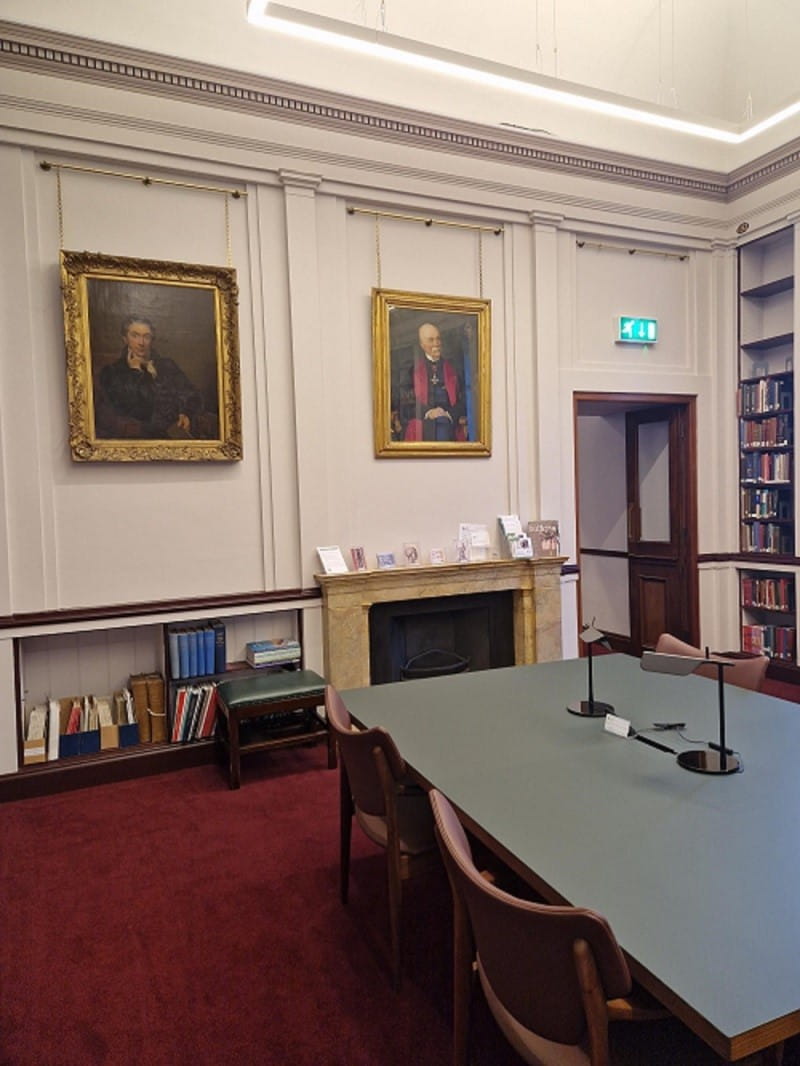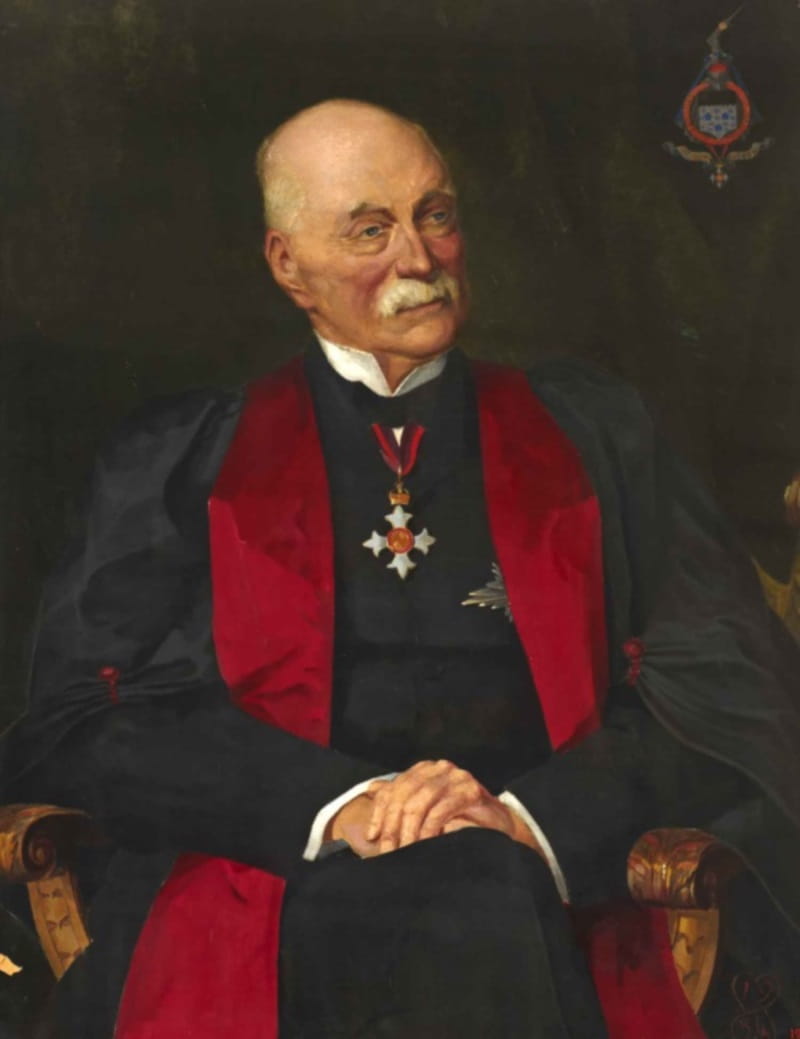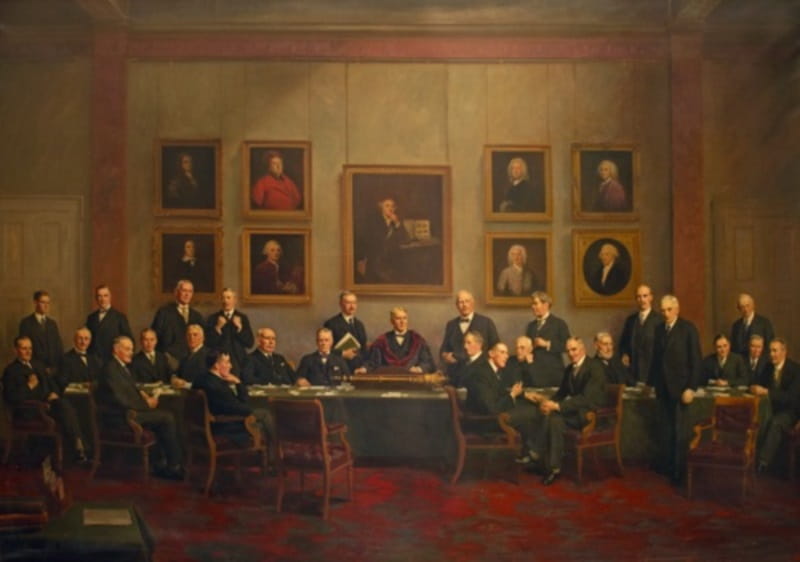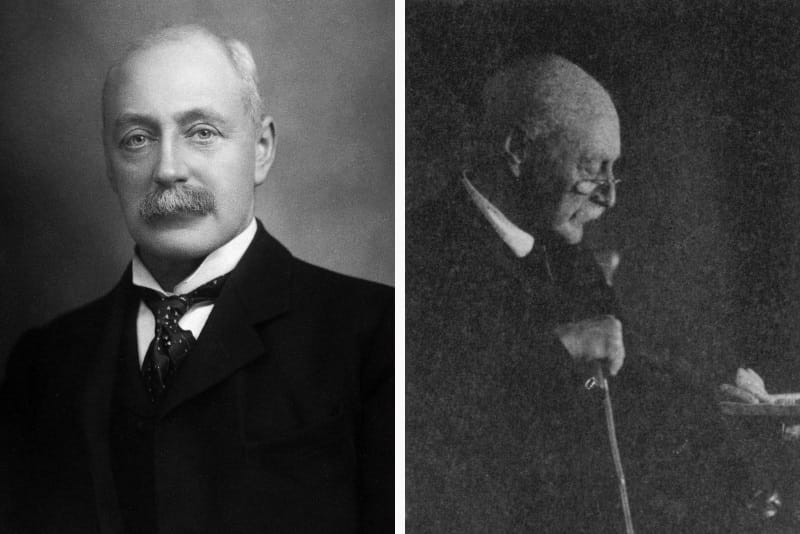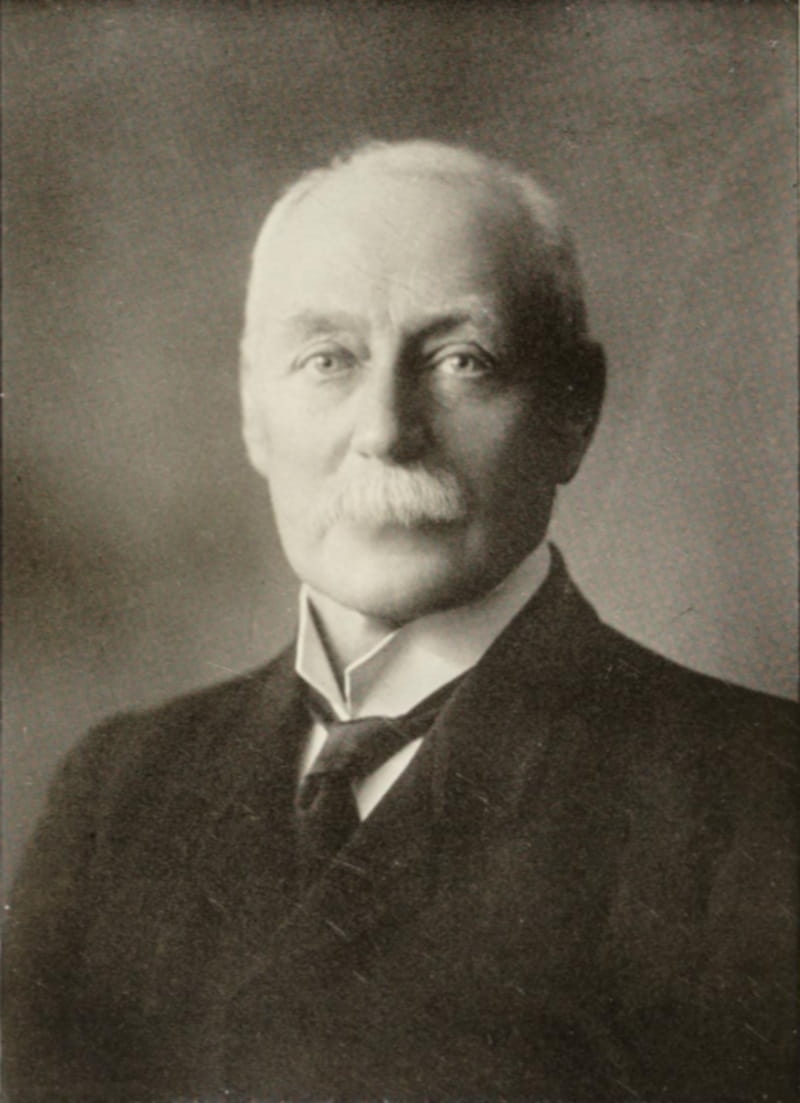Stories from Lincoln’s Inn Fields: Sir D’Arcy Power
20 Feb 2024
Maria Christodoulou
Above: The Members’ Library in the RCS England building.
In the RCS England Members’ Library, above the fireplace sits the portrait of Sir D’Arcy Power, surgeon, academic and our honorary librarian. There is a special place in the college history for Sir D’Arcy for the breadth, scope and richness of his life’s work. This is the story of a prolific polymath and charismatic writer, who engaged proactively with his time and place. The various roles he undertook, his numerous projects and outputs, document a prominent public figure, yet on a more personal note, Sir D’Arcy seems to have left his mark though his affable and positive presence.
But first some biographical information: D’Arcy Power KBE, FRCS, FCA (1855 – 1941) was born on 11 November 1855 at 3 Grosvenor Terrace, Pimlico, in London, to surgeon Henry Power. He initially wanted to be a physiologist, but eventually followed his father into becoming a surgeon. He entered St. Bartholomew's Hospital as a student in 1878 and left as a consulting surgeon and one of the governors in 1920, serving that institution for 59 consecutive years. He proved a skilful surgeon, a popular teacher and author of textbooks and clinical articles. He was active in the medical societies and as a medical journalist, while taking on responsibility as treasurer or president of many of the groups which he joined.
In the same vein, his connection to the Royal College of Surgeons of England is also longstanding and varied. He became a Fellow in 1883, serving as a member of council from 1912 to 1928, and as vice-president for the years 1921 and 1922. He gave the Bradshaw Lecture for 1918, the Vicary lecture for 1920 and delivered the Hunterian oration in 1925. Additionally, but not exhaustively, he was a member of the executive committee of the Imperial Cancer Research Fund; President of the Medical Society of London; President of the Harveian Society of London; President of the History of Medicine Society at the Royal Society of Medicine and was the Mitchell Banks Memorial Lecturer in 1933. Throughout his medical career he was a teacher and examiner and produced textbooks and articles for peer reviewed journals.
Sir D’Arcy also served during the First World War, reaching the rank of lieutenant colonel. He was commissioned as a surgeon in the Volunteer Medical Staff Corps on 25 April 1888 and then mobilised with the outbreak of the war in August 1914, serving until demobilisation in 1920. As a recognition of his service in military hospitals he was appointed KBE.
His influential presence was not only confined to Britain. In 1924 he was visiting surgeon at the Peter Bent Brigham Hospital at Boston, Massachusetts, and in 1930 he paid a second visit to America, when he renewed his old friendships with Fielding Garrison, Harvey Cushing, and other eminent surgeons and scholars. He gave a course of lectures at the W. H. Welch Institute of the History of Medicine at the Johns Hopkins University in Baltimore, subsequently published as The Foundations of medical history in 1931. In 1935 he gave the inaugural address at the opening of the Royal Australasian College of Surgeons at Melbourne. During the long journey to Australia, he dictated his autobiography which remained unpublished at his death.
Above: “Portrait of D’Arcy Power, Vice-President of the College 1921-22, Honorary Librarian, by Matthew Thompson, unsigned, 1934.” From the RCS England museum collection (RCSSC/P 195).
Sir D’Arcy is equally, if not predominantly, remembered for his talent and skill in writing and contribution as a scholar and historian. As noted in his Lives of the Fellows obituary, he was first and foremost a writer. His first published writing appeared when he was only twenty-two. It was titled “On the albuminous substances which occur in the urine in albuminuria”, written with Lauder Brunton for St Bartholomew’s Hospital Reports in 1877, and his first clinical paper appeared in the same Reports in 1882: “A case of hereditary locomotor ataxy”. In the meantime, he had joined Dr Vincent Harris in writing a Manual for the Physiological Laboratory (1880), which ran to five editions in twelve years. His historical work started around 1886 when he edited the Memorials of the Craft of Surgery in England from materials collected by J F South, a voluminous book of almost 400 pages. He also contributed a series of historical articles for the British Medical Journal and the British Journal of Surgery during many years.
While eminent as a surgeon, a professor and a protagonist in the administrative and social life of the profession, he made a notable difference through his scholarly work on the history of medicine and surgery. His interests found fertile ground in London, whether historical, antiquarian, bibliographical or journalistic. Among other roles, he was a Fellow of the Society of Antiquaries of London, President of the Bibliographical Society and a founding member of the Samuel Pepys Club. He regularly wrote reviews for the British Medical Journal, The Lancet, The Times Literary Supplement and other papers. It is well known that for many years he wrote the obituary notices of surgeons for The Times.
In 1929 he became Honorary Librarian of the Royal College of Surgeons, a post created for him on the death of the librarian Victor Plarr, while he was also elected a trustee of the Hunterian Museum. He spent his retirement years in the College library being as productive as ever. His research interests were far and wide, from medical textbooks on surgery, to Samuel Pepys’ diary, to the medical experiences of Benvenuto Cellini, the 16th century goldsmith and sculptor. Through his work he established himself as an authority on medico-historical subjects. The extent of his historical work was beyond any clinical or practical necessity, a testimony to an innate disposition for research and knowledge. As an author he bridged the space between intellectual enquiry and the practitioners, serving them both equally and consistently.
Above: “Group portrait of the College Council 1926-27, by Moussa Ayoub, signed, 1927-29.” From the RCS England museum collection (RCSSC/P 202).
A special mention is warranted for his involvement with the Plarr’s Lives of the Fellows collection of biographies and with documenting the college history. He collected and edited Plarr’s work, after his death in 1929, into the first two volumes of what became known as Plarr’s Lives. Between 1930 and 1940 he wrote, largely from personal knowledge, the lives of almost 400 Fellows who died in those years. Before that he had contributed almost 200 biographies to the Dictionary of National Biography. His extensive work in editing honed a particular skill in condensing life stories, a task he carried through all the way to his 85th birthday, on 11th November 1940, when he presented the two published volumes of Plarr’s Lives to the College’s President and Council. It was apparently his last public appearance before his death in 1941.
A bibliography of his books and papers was compiled by a committee of the Osler Club and was published as his Selected Writings. The volume was presented to him by his friends on his 75th birthday and it records no less than 609 items. Nevertheless, he persevered as he continued writing and publishing for the remaining 10 years of his life.
Above left: “Portrait of D’Arcy Power. Sydenham Medical Club, portraits.” Image from Wellcome Library (Library reference: WMS 6215; Photo number: L0028823), via WikiCommons, licensed under the Creative Commons Attribution 4.0 International license. Above right: “D’Arcy Power”. Image copyright: Royal College of Surgeons of England.
His personal life included a, by all accounts, happy marriage but also loss. Power married Eleanor Fosbroke, daughter of the surgeon George Haynes Fosbroke, in 1883. They had two sons and a daughter. The older son, also called D’Arcy Power, followed his father into part-time service in the RAMC in 1911, and during the First World War became a captain and won the Military Cross. By 1945 he reached the rank of acting air vice marshal and he was appointed Commander of the Order of the British Empire. His younger son, George Henry Fosbroke Power, sadly died at the Second Battle of Ypres in 1915 when he was serving as a lieutenant. Power's daughter also died young of whooping cough while his wife predeceased him in 1923. Even though Sir D’Arcy was no stranger to tragedy, he nevertheless maintained a positive, life-affirming disposition. As mentioned in his Lives entry, he attributed the determination with which he overcame the bereavements in his personal life, to his Yorkshire Quaker ancestry. In forging through life, he ignored his physical disabilities and aging process and consistently saw through the numerous tasks which he voluntarily took upon himself.
Above: “D’Arcy Power aged 56. ” Reproduced from Henry Power Brief sketch of my life, 1912, page 31.
His memorial tributes testify of a congenial personality, charming and friendly, characteristics that also come through his writing. As his close collaborator G.E Gask notes, he had a “pretty pen and a happy phrasing”. While obituaries are not always a reliable or honest assessment of character, there is an obvious fondness when remembering him. In Gask’s touching words:
In his personal disposition D' Arcy Power was happy. He was full of cheeriness, so much so that students, often apt to discern, dubbed him "Sunny Jim", a nickname that stuck. Though he has now gone, and we miss him, we need have no regrets, for his life was pleasing and all our memories of him are pleasant. He was getting very tired, and was glad to lay down his pack.
The searcher of knowledge would appreciate Sir D’Arcy’s broad spectrum of interests, his systematic, methodical approach, as well as his focus on individual biography as a lens through which to view history. As he explained, his method as bibliographer and historian was to seek the individual behind the book; thus, he approached medical history from the biographical aspect and avoided resorting to philosophical generalisations. From this cursory run of a varied life, an interesting and interested figure comes through that merits attention. Sir D’Arcy combined a life’s work of active engagement and service with a positive attitude towards the world and unquenched thirst for knowledge.
A selection of his more important works:
- “Why Samuel Pepys discontinued his Diary”, 1911, The Lancet
- Portraits of Dr William Harvey, 1913, London
- “John Ward and his Diary”, 1917, Trans. med. Soc. Lond. 40, 1
- “The Letters of Boerhaave to Cox Macro”, 1918, Proc. R. Soc. Med. 11, Sect. Hist. Med. 21
- “John Halle and Sixteenth Century Consultations”, 1918, Proc. R. Soc. Med. 11, Sect. Hist. Med. 55
- “The Birth of Mankind or the Woman's Book”, 1927, Library 4 ser. 8, 1
- Medicine in the British Isles, 1930, New York
- Plarr's Lives of the Fellows of the Royal College of Surgeons of England 1843-1930 (1930) 2 vols, revised. Bristol. Supplement 1930-1940 (1953), London
- The Foundations of Medical History, 1931, Baltimore
- A Short History of Surgery, 1933, London
- A Mirror for Surgeons, 1939, Boston
- “The Muniment Room at St Bartholomew's Hospital”, 1940, Bull. Hist. Med. 8, 392
- Power D'A & Thompson C J S, 1923, Chronologia Medica. London
- Power D'A & Waring H J, 1923, A Short History of St Bartholomew's Hospital. London.
Bibliography available at the Library:
- Gask, G. “Sir D’Arcy Power, K.B.E.”, 1941, Nature 148, 45 – Obituary
- Reddy, D. V. S., Sir D’Arcy Power
- Viets, Henry Rouse, Sir D’Arcy Power. 1890-1969, Reprint from New England Journal of Medicine, 1941, Vol 8, N. 225, pp.42-44
- Power, Henry, Brief sketch of my life, 1912
- Power, D’Arcy, Life, history and abstract of work of Sir D’Arcy Power KBE FRCS Eng 1855-1924, 1924
- British Journal of Surgery 1930, vol 18, pag 183-184
- Plarr’s Lives of the Fellows obituary
Maria Christodoulou, Information Assistant

